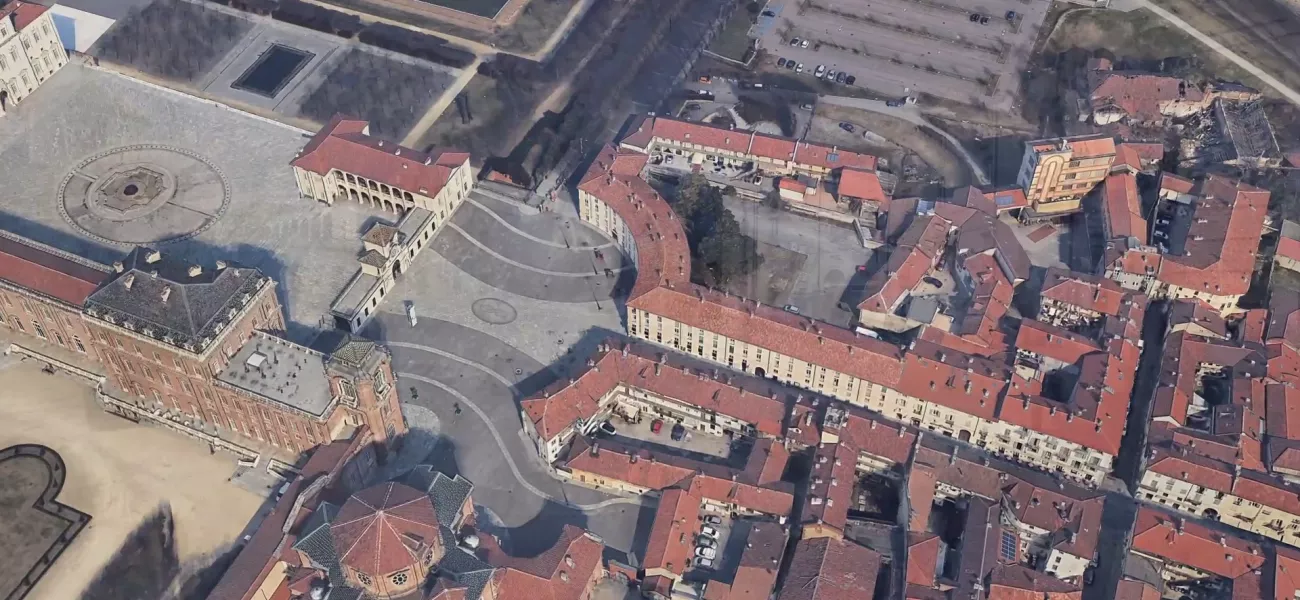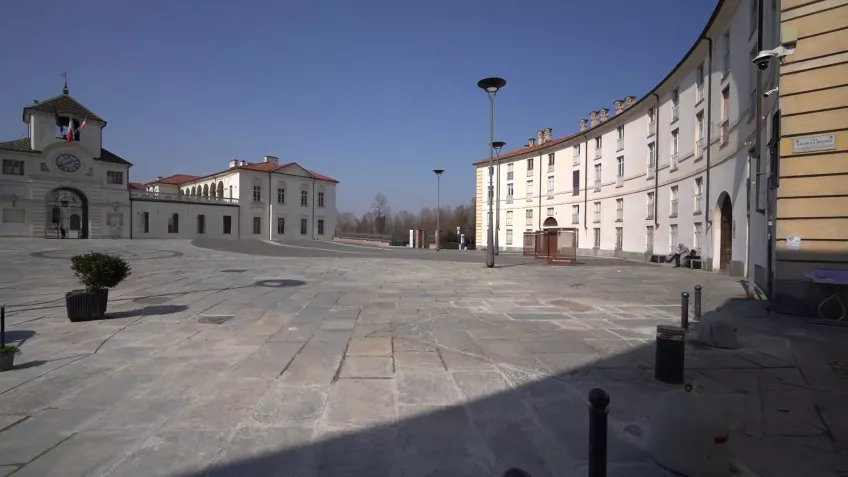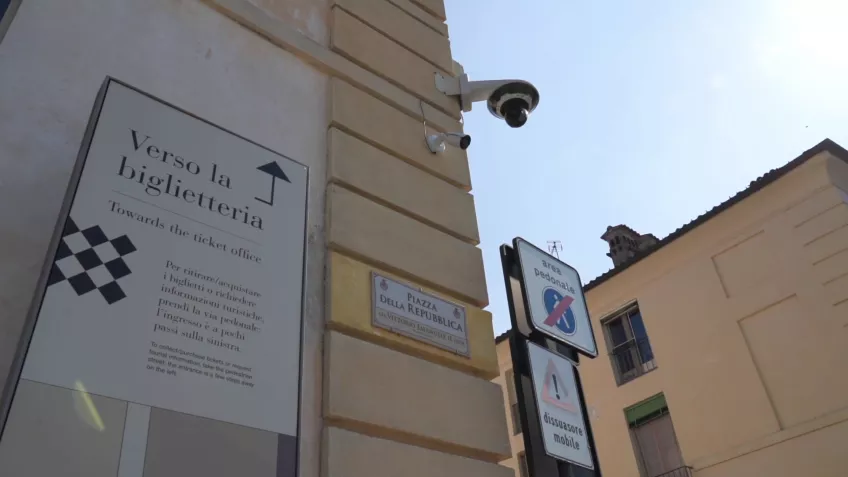
As highlighted in our annual look at the technology trends affecting the security sector, hybrid architecture for video surveillance solutions have now largely become the standard in many security solutions. In this article we look at how the Italian city of Venaria Reale has been using a hybrid solution architecture to not only improve public safety, but to also enhance the experience for visitors in this historic location.
A hybrid solution architecture for a video surveillance solution is one which employs the best attributes of edge, cloud, and server environments. Central to the benefits of hybrid architectures is how data is collected, analyzed, and shared across the environments, providing real-time and longer-term insights to improve security, safety, and operational efficiencies.
Different advantages with edge, cloud and server based storage
Firstly, it’s worth recapping on the benefits delivered by the different environments in a hybrid architecture for video surveillance.
- With security cameras becoming ever more powerful computing devices in themselves, particularly given the AI capabilities embedded at the silicon level, there’s an increasing opportunity to “do more” within the camera itself at the edge of the network. Indeed, complete surveillance solutions that capture, analyze, and store data entirely within the camera are now a reality.
- But while edge capabilities in themselves are increasingly advanced, using the data (and metadata) created in the edge in other environments amplifies the potential. Securely transferring data to cloud-based analytics and data dashboard applications brings additional layers of insight to organizations, supporting security, safety, and operational use cases.
- Servers still play a critical role in security solutions. Storage of data over the long-term (whether on premise or in data centers) can often be a regulatory demand or simply just desirable for specific organizations. Increasingly, however, the significant amount of information captured over time can be mined to identify patterns and surface trends that support more effective planning of infrastructure and resources.
Each environment has an important role to play, which is why hybrid architectures using the best attributes of each have become the norm. The historic city of Venaria Reale in northern Italy provides a great example of the benefits.
Welcome to the city of Venaria Reale!
Venaria Reale, a city in the metropolitan area of Turin, attracts thousands of tourists every year to see its beautiful buildings and visit the numerous shops, cafés, and restaurants lining the city’s streets.
Many visitors come specifically to see the Royal Palace of Venaria Reale, a UNESCO World Heritage Site, and one of Italy’s most positive tourist attractions. The piazza immediately in front of the Palace can become extremely busy, and city authorities need to manage occupancy and quickly react to incidents to ensure the safety of visitors and citizens.

Those in charge of the city’s economic development are also keen that tourists find their way from the Palace to the surrounding streets and piazzas, supporting local business and showing visitors more of what Venaria Reale has to offer.
The foundation for both objectives is a clear understanding of when people and different types of vehicles gather and move around the city, and different triggers that can alert authorities to incidents.
A security solution based on a hybrid architecture
Alongside the system integration partner ASM Venaria, Axis has worked with the City of Venaria Reale since 2010, providing security cameras which allow law enforcement officers to monitor key areas of the city, manage the flow of visitors, and respond to incidents.
Mario Corrado, Director, ASM Venaria, explained why a hybrid architecture provided the ideal solution: “We believed that a solution combining Axis cameras, video management software (VMS), cloud-based services, and data dashboard software, would most effectively meet the city’s new objectives. Our approach has the benefit of using the city’s existing surveillance infrastructure while allowing the solution to be enhanced over time.”

The solution’s architecture leverages existing video surveillance infrastructure, edge analytics, and cloud-based web services. Data is generated by Axis cameras and transferred to a fast, scalable, and serverless time-series database service, which enables simple data storage. This then feeds a data visualization dashboard, from which the city of Venaria Reale can analyze the data and extract insights.
Valuable data in real-time and over the long-term
For Venaria Reale’s law enforcement officers, real-time information about occupancy levels in key areas and live views of the scene are still essential in ensuring public safety throughout the city.
To achieve this, the solution makes use of analytics including crossline counting and occupancy in an area.
Together these provide estimated occupancy levels and detail of the total number of people and vehicles entering and leaving the city’s streets and piazzas. In addition, the data derived from the analytics contains information that can be used to create ‘heat maps’ and visualizations of particularly busy areas.
The analytics create alerts when certain thresholds are met in different piazzas and along the street, allowing operators to view the scene and, if required, deploy additional officers to encourage people to move to less crowded areas.
Law enforcement personnel also have visibility of the number and types of vehicles in the street at any time, and again can react when traffic combined with tourists starts to head towards potentially dangerous levels.
The addition of audio speakers to the solution also allows remote operators to direct crowds to disperse, or communicate other attractions around the city to visit, managing crowded areas and ensuring that visitors get the fullest possible experience.

Alberto Pizzocaro, Venaria Reale’s Chief of Local Police, expands on the solution’s benefits: “Up until now, our operators have had to rely solely on their experience and intuition to judge the level of crowding when monitoring areas of the city in real-time. Today, their insight is being enhanced by intelligent software that manages and analyzes anonymized data – ensuring the privacy of citizens and visitors – and combines this numerical data with live visual information. Automatically and accurately monitoring the number of people in specific areas with visual verification of the situation on the ground is the ideal solution.”
Adding sound detection for further insights
In addition to video surveillance, the solution also includes sound detection as another data input. Using air pressure to detect and pinpoint sounds above a certain threshold (no actual audio is recorded), pan, tilt, and zoom surveillance cameras can be automatically directed towards the sound, giving operators an immediate real-time view of the scene.
Through the same hybrid architecture, the sound detection data is added to the data dashboard and aligned with the video data. Through alerts in the VMS, operators can quickly review the video data associated with the sound detection to establish the cause. Such insights can help authorities understand when crowding causes a higher than desirable level of noise in the city, or that garbage collections or deliveries are scheduled for less busy hours.
Longer-term data analysis brings additional benefits
The ongoing collection and dashboarding of data from the security cameras, sound detection, and analytics – combined with visual verification – is bringing further insight aiding public safety, economic development and, in the future, the city’s sustainability goals.
While the data dashboard tells a story about ‘what’ happened at a point in time – for instance a peak in the occupancy levels of a particular area – the video and audio information for the same location at the same time provides the ‘why’ it happened.
For instance, groups of tourists might be waiting for a tour to start, or for a particularly popular gelateria to open. This combination of data has become hugely valuable to the city in enhancing the experience for visitors.
Endless future possibilities with a hybrid solution architecture
Gazing into the future, and an almost infinite number of potential applications can be imagined. For instance, the analysis of flows of traffic and their type could also help with improvements in city services. These might include increasing public transport during peak periods, improving signage to encourage tourists to visit other parts of the city, adjusting the timing of deliveries so that they take place in less busy periods, all of which would improve both public safety and the experience for visitors.
Moving forward, being able to accurately measure the occupancy levels of the city’s piazzas and streets could enable the city to take steps to reduce energy consumption, for instance by dimming streetlights during quiet times of the night. This can be achieved without an impact on public safety: the low-light capabilities of the surveillance cameras will ensure that there’s no loss of visual detail or data usability during these periods.
The data provided through this innovative project gives us a comprehensive view of what is happening in the city's pedestrian streets and informs us of ways we can optimize our services and infrastructure to further improve the experience of those who live in or visit the Reale.
Fabio Giulivi, Mayor of Venaria Reale, concludes: “Central to our objectives is to provide the best possible experience for visitors to Venaria Reale, and to support the city's businesses in their growth. The data provided through this innovative project gives us a comprehensive view of what is happening in the city's pedestrian streets and informs us of ways we can optimize our services and infrastructure to further improve the experience of those who live in or visit the Reale. As they say, you can't improve what you don't measure, and this data is an essential source for developing new projects and attracting new investors."
The experience in Venaria Reale is just one example of how the combination of data and its analysis across a hybrid solution architecture brings both immediate benefits and provides the foundation for multiple future applications. If you haven’t yet explored the potential of hybrid architectures, perhaps 2024 is the year to investigate?